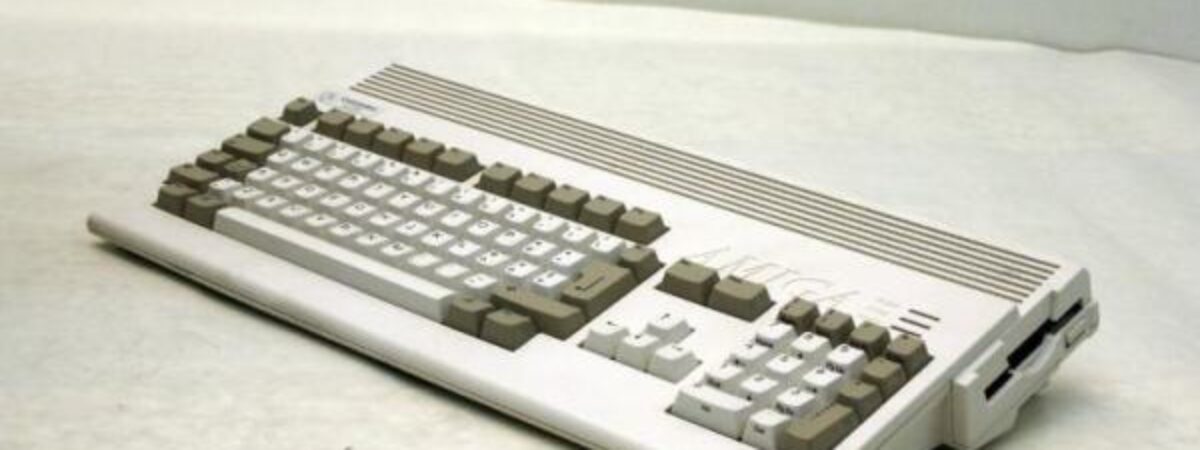Throwback Thursday: the Amiga A1200
Ah, the Amiga A1200. If you’ve read my previous post about the A600, you’ll have hopefully gotten a sense of my love of the Amiga line of computers.
The Amiga A1200 was released just after the A600 back in 1992, but was a significantly more serious machine. Fully 32bit, and powered by the Motorolla 68020 CPU, running at a staggering 14.18MHz (or, again, 14.32MHz in NTSC mode), and coupled with 2mb of Chip Ram and the holy grail of Amiga chipsets – the Advanced Graphics Architecture (AGA) chip.
You could also drop in up to 8MB of additional RAM via a handy trapdoor slot, or a staggering 256MB of extra memory if you coupled it with a CPU upgrade – and you could upgrade this beast all the way up to the flagship 68060 CPU. Oh yeah. Through this port, and with much, much hackery (i.e. ripping the innards out and shoving them into a tower case), you could also add Zorro expansion ports to it. Zorro ports were the Amiga’s equivalent to ISA and PCI slots on early PC’s, allowing discrete graphics cards, soundcards and other upgrades to be added. One really cool feature of Zorro, actually, was that the CPU could directly access any memory installed via those slots (think Resizable Bar), meaning you could also buy RAM expansion boards that dropped right in and allowed use of much cheaper, and industry standard SIMMs to add RAM.
Unlike the A600, the A1200 featured a full size keyboard with number pad, but like it’s pint sized brother it also featured an industry standard IDE connection and a PCMCIA port for adding PC Card peripherals, such as modems, network cards, SCSI Controllers and, later on, even USB ports.
Although popular with the amateur music production community and video production folks, the A1200 probably arrived a little late in the day. A couple of years earlier and maybe Commodore’s fall from grace may have been a little more graceful than the complete collapse they underwent instead.
We upgraded to an A1200 a few years after getting the A600. I believe my uncle was selling his to upgrade to a PC, so we inherited them and other than the much upgraded gaming experience, having more memory and better hardware just encouraged me to learn more coding based stuff.
It was on the A1200 I discovered AmigaGuide and learned I could write it myself. AmigaGuide was a hypertext document format that allowed you to link pages together via inline links. You could also embed images, sounds and animations, which made it the default format for electronic documentation for software on the Amiga.
Around this time, I’d also discovered Ian Livingstone and Steve Jackson’s Fighting Fantasy game books; you know, the “choose your own path” style books? Combining the two, I spent many an evening writing my own, interactive adventures in AmigaGuide which was what eventually led me to HTML and a career in tech. Well, this and the fact that I needed to do a presentation for school and, while everyone else had a PC and a copy of PowerPoint, I didn’t. So, in a moment of madness, I decided to make my presentation in HTML and present it in a web browser instead. Each “slide” was a fully hand-cranked HTML page, written in a basic text editor and copied to a 720k double density floppy disk. This was in around 1999, too, so CSS was still in its infancy.
From this, I also dabbled with BASIC and AMOS, often typing out programs and scripts from magazines to make my own games and demos. I never really got very far with that, but it definitely unlocked an interest in me that persists to this day.
The A1200 also introduced me to the world of networking, long before I even knew what a modem was. Using the Amiga specific Parnet and Sernet libraries, and some horribly soldered, modified parallel and serial cables, I experimented with network computing – in a limited fashion; the two machines were sitting next to each other and data transfer was slower than writing to a floppy disk, and then swapping that disk into the other machine.
At some point, however, I moved on. We bought a PC (remember when it was the “family” PC?), and that came with modern software and a modem. I discovered the Internet, too. And, with that, MS Frontpage which helped guide me on further explorations into the world of HTML, CSS and, eventually, JS. And the rest really is history.
I loved the Amiga’s. My dad still has them in the shed and, if I had space, I’d steal them back and have them set up in my house so I could pick up where I left off. For any retro enthusiasts out there, I’d highly recommend picking one up. You’ll love it.

